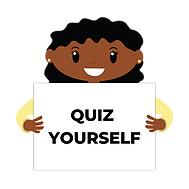CLICK “PLAY” TO TURN ON.
This is a YouTube client post from an unknown salon.
Please note there is no such thing as a hypoallergenic lash glue.
(This is misinformation given by the lash salon she went to and many others. Please never tell a client this.)
Just as every client’s eyelashes are different, client reactions to certain products may be different as well. Allergies and sensitivities differ from client to client. You won’t always be able to avoid reactions, but you should know how to minimize and respond when it happens. Always remember to stay calm and professional, and if their reaction is severe, recommend they see a medical professional. There is a repetition of information on this page because understanding everything on this page is very important before you start seeing clients.
KEY
THINGS
TO
REMEMBER
ABOUT
LASH
ALLERGIES
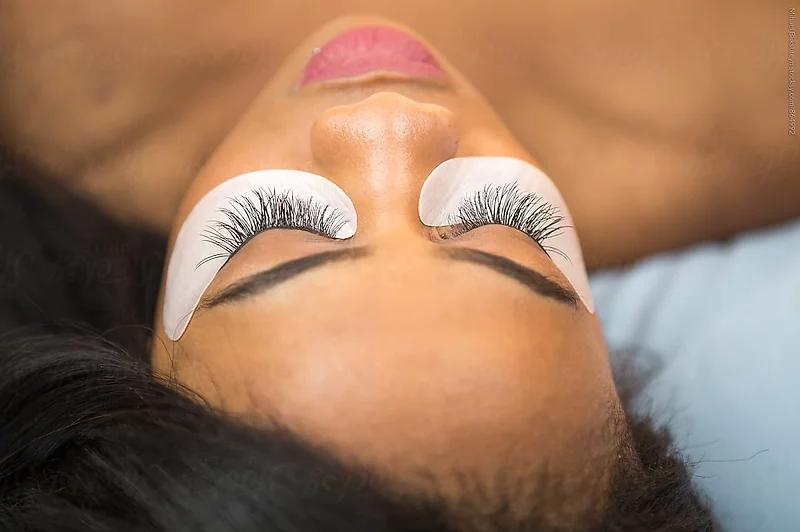
The human eye is an extremely sensitive area and a patch test is necessary to ensure your client’s safety. It is recommended that the patch test is done at least 3 days in advance of the appointment.
Tip: If you find your entire schedule getting booked with free consultations, you could consider charging a small fee for the consultation and patch test ($10-20). Let clients know that this small fee would be deducted from their full set.
HOW TO CONDUCT A PATCH TEST
OPTION 1: APPLY A FEW LASHES
- Have the client fill out your intake form (this is in your manual) and ensure no contraindications exist. Ask if they have ever had any allergic reactions to acrylic of any kind, as there is a form of acrylic in the lash extension glue. Also, ask if they have ever had a reaction to medical tape. If not, proceed.
- Clean their lashes with your lash foaming cleanser, prime their lashes with witch hazel, and apply the under eye pad or tape.
- Apply 10-15 eyelash extensions on each eye. Use a lash extension length similar to the client’s natural lashes so they don’t leave looking funky with only 10 long lashes on each eye. This is not supposed to be noticeable. You are just putting on enough to elicit a possible allergic reaction.
- Ask the client to contact you if they have any reaction. Most allergic reactions will show themselves as puffy and/or flaky eyelids.
- If any redness or irritation occurs within the first 3 days, cancel your upcoming lash extension service and offer them a complimentary removal of the lashes you applied.
OPTION 2: APPLY A TINY BIT OF GLUE BEHIND THE EAR
- Have the client fill out your intake form and ensure no contraindications exist (ask if they have ever had any allergic reactions to acrylic of any kind as there is a form of acrylic in the lash extension glue) and if they have ever had a reaction to medical tape. If not, proceed.
- Clean behind the ear with your lash foaming cleanser.
- Apply a drop of glue to the tip of a microfiber wand (do not put on a cotton swab because the glue reacts with cotton and it could start creating smoke).
- Apply a dot of glue behind the client’s ear.
- Ask the client to contact you if they have any reaction. Most allergic reactions will show themselves as puffy and/or flaky eyelids.
- If any redness or irritation occurs within the first 3 days, cancel your upcoming lash extension service and offer them a complimentary removal of the lashes you applied.
CONTRAINDICATIONS
If any of the following applies to your client, DO NOT do the lash extension service.- Allergy to acrylics.
- Reaction to the patch test
- Cyst or stye on eyelash line or lid
- Blepharitis
- Chemotherapy (currently undergoing)
- Cut, skin trauma, burns or swelling around the eyes
- Weak eyelash hair
- Eye infection (such as pink-eye)
- Recent operation around the eyes
- Watery eyes
- Hypersensitive eyes/skin
- Keratitis (inflammation of the cornea of the eye)
- Alopecia (loss of hair)
- Bells Palsy or any other condition that makes the closing or opening of the eyes difficult.
ALLERGIC REACTIONS
If you apply lashes long enough, YOU WILL have clients who develop allergic reactions.
The more educated you are about it, the less you will “freak-out” when it happens.
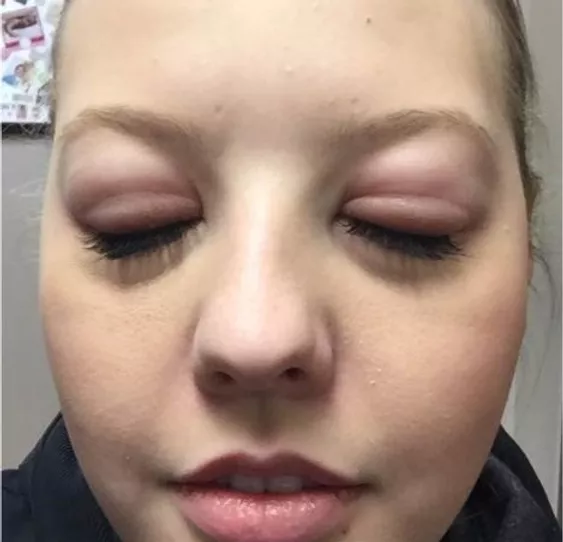
Issue: My client’s eyelids are puffy!
Disclaimer: We are not eye doctors and cannot give you medical advice. We are just sharing what we have seen with clients and ourselves over the years.
If your client’s eyelid skin is puffy and pink, she/he is most likely having an allergic reaction to the adhesive. Some people develop an allergy to cyanoacrylate, a type of acrylic, which is in the adhesive. This ingredient is in every eyelash extension adhesive made in the world. There are some “sensitive” adhesives on the market which contain less cyanoacrylate but the lash extensions will not stay on longer than a week with the minimized amount of this ingredient. We do not recommend using the “sensitive” adhesive because it will still trigger an allergic response (if your client is allergic) and the lashes won’t last very long, so what’s the point in getting them?
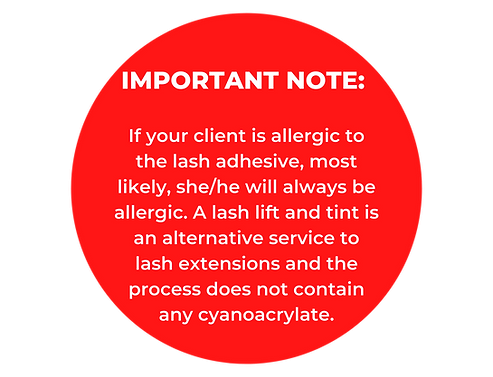
What do you do if your client has an allergic reaction?
First, we are not doctors but from our experience, these are the best following steps:
- Stay calm, it will be okay!
- Schedule a removal (no burn cream remover is best…gel remover can sting the already sensitive skin).
- Get a removal within a couple of days of the allergic reaction.
- Have your client check with their doctor to see if it’s okay for them to take an antihistamine, such as Benadryl. They may advise she/he take it for a few days until the allergic response goes down.
- Ask the client not to rub or further irritate the eyelids.
MORE INFO ABOUT A LASH GLUE ALLERGY
A small percentage of clients will with repeated exposure, develop an allergy to the cyanoacrylate in the eyelash extension glue. All eyelash extension glue contains cyanoacrylate, as that is the primary ingredient that allows the lash extensions to actually stay on the lashes until the natural lash sheds.
There are “sensitive” lash extension glues on the market with a lower amount of cyanoacrylate in the glue but even with less of it in the glue, the client will still have a reaction and these glues don’t tend to allow the lash extensions to last very long on the client.
Some clients may present the allergy within 3 days of your patch test. Others will have been getting lashes applied for years and suddenly develop the allergy.
If a client calls and they say they have any or all of the following symptoms, inform them that you are not a doctor but from your experience, this sounds like they are having an allergic reaction:
- Swollen eyelids within the first 3 days of their last lash extension appointment.
- Flakey/dry eyelids within the first 3 days of their last lash extension appointment.
Again, remind them that you ARE NOT a doctor but this is something that occurs in a small percentage of clients after repeated exposure to the cyanoacrylate in the glue. Once the allergy develops, it does not usually go away and you recommend that they get the extensions removed ASAP. Many clients also find taking an over-the-counter antihistamine helpful (but your client should check with their doctor to make sure that is okay for them).
UNDER-EYE PAD/LASH TAPE ALLERGY
A few clients may be allergic to the sticky part of medical tape or the back of the eye pad. If this occurs, the client’s under-eye skin may feel itchy during the service or irritated after the service. If this occurs, make sure you add it to your notes and use a different tape or eye pad the next time they are in.
Red Eyeballs
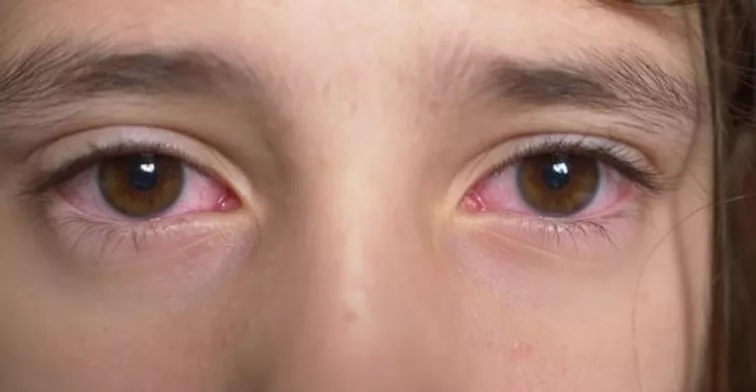
Disclaimer: We are not eye doctors and cannot give you medical advice. We are just sharing what we have seen with clients and ourselves over the years.
My client’s eyeballs are red!
Sometimes after getting lash extensions applied, a client’s eyeballs (eyelids are addressed in the section above) will be irritated and red. This can happen for a few different reasons listed below.
- The client left their contacts in during the service. Leaving contacts in with eyes closed can irritate the eyes because the contacts get dry. This is no different than taking a nap on your couch with your contacts in. Treat as you normally would if you slept in your contact lenses. Most people just put in eye drops and the redness subsides. Always keep contact solution and disposable contact lens cases at your salon so clients have the option to remove their contacts before the service. Throw away the contact case at the end of the service. DO NOT sanitize and reuse.
- Your client opened their eyes during the service. The adhesive we use is strong and the fumes can irritate the eyes if they open during the service (even opening them a little tiny bit). This is not an emergency but should be addressed quickly if the client feels any stinging/burning sensations. To address, dry the lashes with the dryer and nano-mist with water. Keep repeating until the sensation subsides. If the eyes are red after the service, most people put in soothing eye drops and the redness subsides within a few hours to a day.
- The client talking/laughing/moving during service. When a client talks, laughs or moves while having lash extensions applied, their eyes usually open a little bit.
- If your client has a dark red spot below the iris (pictured below), the tape may have moved and rubbed their eyeball. This typically occurs when the client’s eyes water and the pad unsticks from the skin and moves into the client’s eye or when the client talks and the pad moves up into the eye. If your client feels like the pad is poking her/him in the eye, adjust the eye pad, or apply a new one. In our experience, the red spot lasts about 3-7 days and there is not a lot you can do to get rid of it before then because your eye needs to heal from the bruise. This can be completely avoided. How?
- Check-in every 20 minutes or so and ask, “Is anything stinging or poking?”
- If the pad has moved close to their eye, dry the lashes, mist with the nano-mister, turn off your light, and move or remove and reapply the eye pad.
- Tell the client at the beginning of the service, “If anything feels uncomfortable at any time, please let me know. It will not hurt my feelings. This should be a comfortable and pain-free experience for you.”
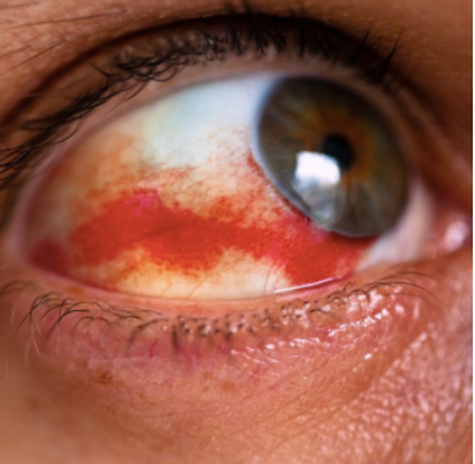
Blepheritis
There are several possible causes of blepharitis, including:
- Bacterial eyelid infection
- Meibomian gland dysfunction (MGD)
- Dry eyes
- Fungal eyelid infection
- Parasites (Demodex eyelash mites)
Blepharitis and dry eyes often occur at the same time, causing confusion whether dry eye causes blepharitis or blepharitis causes dry eye. This happens so often that some researchers and eye doctors now believe these two conditions may be part of a single chronic eye problem called dry eye blepharitis syndrome (DEBS). According to supporters of this theory, dry eye is simply the late manifestation of blepharitis, and treating blepharitis also will prevent, reduce or eliminate dry eye symptoms.
Blepharitis usually is associated with an overgrowth of bacteria that live along the margins of the eyelids and at the base of the eyelashes. Over time, these bacteria multiply and create a structure called a biofilm.
This biofilm becomes a toxic environment — like the plaque that forms on your teeth. Parasitic eyelash mites called Demodex feed on the biofilm, which in turn leads to an overgrowth of these mites that causes a worsening of the eyelid inflammation.
Bacteria in the eyelid biofilm also produce substances called exotoxins that cause inflammation of oil-secreting glands in the eyelids called meibomian glands. This causes a condition called meibomian gland dysfunction, which causes (and worsens) dry eye discomfort.
Blepharitis also is frequently associated with skin conditions, such as ocular rosacea, eczema, dandruff and psoriasis. And often, blepharitis and pink eye occur at the same time.
The most common symptoms of blepharitis are:
- Burning or stinging eyes
- Crusty debris at the base of eyelashes
- Irritated, watery eyes
- Itchy eyelids
- Grittiness or a foreign body sensation
Depending on the severity of blepharitis, you may have some or all of these symptoms, and blepharitis symptoms may be intermittent or constant. In some cases, blepharitis also causes loss of eyelashes (madarosis).
Blepharitis also is a common cause of contact lens discomfort, forcing many people to give up wearing contacts.
Treatment of blepharitis should begin with a visit with your eye doctor to determine the cause of your eyelid inflammation. Your doctor will examine your eyes and eyelids to evaluate whether you have blepharitis and determine what type of blepharitis treatment is most appropriate.
Typically, blepharitis treatment includes:
- Eyelid scrubs. Gently scrubbing your eyelids removes the buildup of biofilm and excess bacteria from your lid margins. Your eye doctor typically will recommend a daily regimen of warm compresses and lid scrubs to clean your eyelids and reduce the amount of bacteria and Demodex mites on your lids. Cleaning agents may include prescription eyelid cleansers (Avenova or Cliradex), non-prescription eyelid cleansing pads (Ocusoft; Systane), or diluted baby shampoo.
- In-office procedures. Though eyelid scrubs at home are helpful, in-office eyelid hygiene procedures often are recommended for more effective blepharitis treatment. Possible procedures include:
– Electromechanical lid margin debridement (such as BlephEx treatment) to efficiently remove bacteria, biofilm and Demodex mites from your eyelids and open clogged meibomian glands. - Thermal pulsation treatment (Lipiflow, for example) to melt and express material obstructing the meibomian glands.
- Intense pulsed light (IPL) therapy to open clogged eyelid glands and resume normal flow of oils into the tear film.
- Medicated eye drops and/or ointments. Your doctor also may prescribe topical medicines to destroy excess blepharitis-causing bacteria or other microbes on the eyelids — particularly if there is a risk of eye infection or it appears you have pink eye or some other type of eye infection as well as blepharitis.
Pink Eye (Conjunctivitis)
Quiz Yourself
Answer the questions below and then check your answers by clicking the down arrow next to it. Just a reminder…there is a final exam at the end of this course and in order to receive your certificate, you will need to pass it. Re-read the information above if you didn’t pass the quiz below.
The client left their contacts in during the service. Leaving contacts in with eyes closed can irritate the eyes because the contacts get dry. This is no different than taking a nap on your couch with your contacts in. Treat as you normally would if you slept in your contact lenses. Most people just put in eye drops and the redness subsides. Always keep contact solution and disposable contact lens cases at your salon so clients have the option to remove their contacts before the service. Throw away the contact case at the end of the service. DO NOT sanitize and reuse.
Your client opened their eyes during the service. The adhesive we use is strong and the fumes can irritate the eyes if they open during the service (even opening them a little tiny bit). This is not an emergency but should be addressed quickly if the client feels any stinging/burning sensations. To address, dry the lashes with the dryer and nano-mist with water. Keep repeating until the sensation subsides. If the eyes are red after the service, most people put in soothing eye drops and the redness subsides within a few hours to a day.
The client talking/laughing/moving during service. When a client talks, laughs, or moves while having lash extensions applied, their eyes usually open a little bit.
If your client has a dark red spot below the iris, the tape may have moved and rubbed their eyeball. This typically occurs when the client’s eyes water and the pad unsticks from the skin and moves into the client’s eye or when the client talks and the pad moves up into the eye. If your client feels like the pad is poking her/him in the eye, adjust the eye pad or apply a new one. In our experience, the red spot lasts about 3-7 days and there is not a lot you can do to get rid of it before then because your eye needs to heal from the bruise.
This can be completely avoided. How?
Check in every 20 minutes or so and ask, “Is anything stinging or poking?”
If the pad has moved close to their eye, dry the lashes, mist with the nano-mister, turn off your light, and move or remove and reapply the eye pad.
Tell the client at the beginning of the service, “If anything feels uncomfortable at any time, please let me know. It will not hurt my feelings. This should be a comfortable and pain-free experience for you.”

